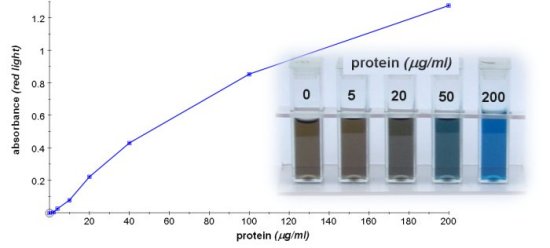Bradford test for proteinThe Bradford assay is a very good, and simple, method of detecting microgram quantities of protein. However the test is specific for certain amino acids, principally arginine, so not all proteins give the same reaction. For example albumin, casein and gelatin all give different responses. Gelatin has a very weak response to Bradford reagent since the protein, which is partially hydrolysed collagen, contains very few of the amino acids to which the reagent is sensitive. The standard usually employed is bovine serum albumin, (BSA). This is relatively expensive. We have used powdered egg white from the home-baking section of our local supermarket as the standard with results comparable to BSA. The reagent contains Coomassie Blue dye which is light brown in the reagent but blue when bound to protein.
Add 2.5cm3 of the reagent, (stock solution diluted 1+4 with water), to 0.25cm3 of the sample solution.
Microassay

|
||||||||||||||||




